|
 Long
ago, blue was restrictedly reserved for royalty, partly due to the
complex process necessary to achieve what was once a "rare"
colour. But with time and the Industrial Revolution, it was democratized
and now enjoys universal popularity. Some samples of its popularity
can be seen in spring 2006 collections from Libertine, Afshin Feiz,
Lela Rose, Gottex, and the cute baby blue babydoll shift dress from
Cynthia Rowley. Blue is represented in this exhibition by historical
costumes featuring royal blue, deep indigo blue and vivid purple
(the KCI's English Mantua dress, c.
1740s–1750s). Long
ago, blue was restrictedly reserved for royalty, partly due to the
complex process necessary to achieve what was once a "rare"
colour. But with time and the Industrial Revolution, it was democratized
and now enjoys universal popularity. Some samples of its popularity
can be seen in spring 2006 collections from Libertine, Afshin Feiz,
Lela Rose, Gottex, and the cute baby blue babydoll shift dress from
Cynthia Rowley. Blue is represented in this exhibition by historical
costumes featuring royal blue, deep indigo blue and vivid purple
(the KCI's English Mantua dress, c.
1740s–1750s).
Focusing on the 18th century, the Red and Yellow
sections examine the relationship between colour and international
trade, especially the ancient China dye trade and the voyages of
explorations that led to the discovery of new dyes and colour techniques.
A bright yellow English robe à la française gown from
the 1760s in silk taffeta and Junya Watanabe's 2000 red and yellow
jacket and skirt ensemble best exemplify the process we have made
on this front and are excellent barometers of how our yearning for
self-expression and personal taste has driven our love colour in
general.
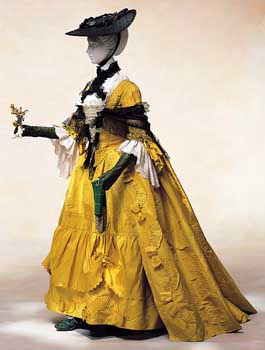
The final section of the exhibition is devoted
to the color White, which has long been seen as a symbol of purity,
innocence and hope in the west and a colour of mourning in the east.
The dresses on view include a gauzy and ethereal white flapper-style
dress by Coco Chanel from 1926 and a wedding dress (inspired by
a nun's habit—how ironic is that?) by Madame Vionnet from the
1930s.
The Smithsonian's Cooper–Hewitt, National
Design Museum, is the only museum in the United States devoted exclusively
to historic and contemporary design, presenting perspectives on
the impact of design on daily life through active educational programmes,
exhibitions and publications. Founded in 1897 by Amy, Eleanor and
Sarah Hewitt—granddaughters of industrialist Peter Cooper—as
part of the Cooper Union for the Advancement of Science and Art,
it became a part of the Smithsonian's portfolio of national museums
in 1967, and has holdings encompassing one of the most diverse and
comprehensive collections of design work in existence, tracing the
history of design through more than 250,000 objects spanning 24
centuries, from the Han Dynasty (200 BC)
to the present.
The Kyoto Costume Institute, founded in 1978
by charter from the Agency for Cultural Affaires, is the only institution
in Japan that specializes in the study of western fashion and engages
audiences worldwide through its exhibitions and publications on
fashion. It recognizes and appreciates the fashionable clothing
are beautiful pieces of art as well as examples of fine craftsmanship,
and acknowledges the merit of studying clothing in order to see
how fashion will evolve in the future. Since its establishment,
KCI has worked to deconstruct the
conventional framework of fashion and has contributed ground-breaking
scholarship in the field through its five full-scale exhibitions
in the last 25 years, including Japonism in Fashion (1994,
covered a few years ago in Lucire), a scientific approach
that examined the influence of Japanese culture on western fashion
and Japonism in the broader sense.
Fashion in Colors will be curated by the
Kyoto Costume Institute's Chief Curator, Akiko Fukai and Cooper-Hewitt's
Curatorial Director Barbara Bloemink, with illumination design by
Leni Schwendinger Light Projects Ltd. and exhibition design and
signage by Tsang Seymour Design. It will be accompanied by a full-colour
exhibition catalogue published by Assouline, featuring photography
of the fashion on view, with essays by Mr Fukai, Ms Bloemink, Claude
Lévi-Strauss, Lourdes Font, Claude Imbert, Yasuo Kobayashi
and Dominique Cardon. •
Phillip Johnson is features' editor for Lucire.
|
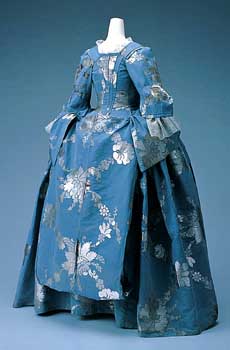 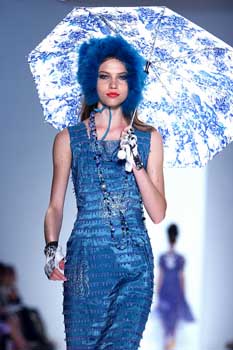 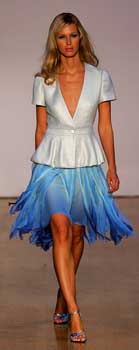 TOP LEFT, INSET:
Cynthia Rowley spring 2006. FAR LEFT:
Robe à la française, England, c. 1760. TOP:
Mantua silk taffeta brocade dress, England, c. 1740s–1750s.
ABOVE: Libertine, spring 2006. LEFT:
Afshin Feiz, spring 2006. BELOW:
Junya Watanabe jacket and skirt, 2000.
TOP LEFT, INSET:
Cynthia Rowley spring 2006. FAR LEFT:
Robe à la française, England, c. 1760. TOP:
Mantua silk taffeta brocade dress, England, c. 1740s–1750s.
ABOVE: Libertine, spring 2006. LEFT:
Afshin Feiz, spring 2006. BELOW:
Junya Watanabe jacket and skirt, 2000.
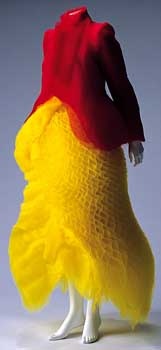
|
 Read
more in the November 2005 issue of Lucire. Read
more in the November 2005 issue of Lucire.
To make sure you don’t miss out, click
on the image at right to subscribe
or purchase a single copy. (Click 'Yes' if pop-up boxes appear—you're
being switched to our secure server and it is completely safe.)
|
|

